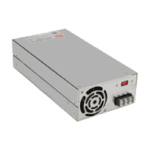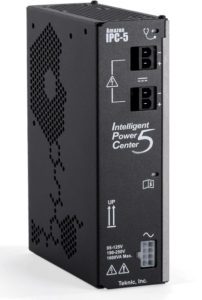In a recent online article, Teknic engineers have outlined how dc-powered motion-control applications differ from most other dc-powered designs … and how the motors in these applications need specialty power supplies. The article focuses on dc power supplies, which are the most common and suitable for fractional-horsepower motors.
What makes dc motion-control applications unique are their high peak-to-continuous power ratios … and inclusion of regenerative energy systems to recapture and reuse energy. During situations involving the latter, the spinning motor rotor acts as a generator to generate and send current back into the power supply.
As the Teknic engineers explain, there are three leading options for the powering of these dc stepper and servomotor applications.
1. Unregulated bulk-linear power supplies

Unregulated bulk-linear power supplies — consisting of a transformer, rectifier, and large filter capacitor — have high output capacitance. That means they’re suitable for motion applications but can be bulky.
Additionally, because they’re unregulated, their output voltage can droop significantly during high peak-power demand. Other disadvantages of bulk-linear power supplies can include a sensitivity to varying ac line conditions, lack of protective enclosures, and high in-rush current.
️ ✴️ Teknic uses the term bulk linear to distinguish these supplies from expensive linear regulated supplies employed in non-motion systems that are sensitive to EMI.
2. PWM switching power supplies
In contrast with unregulated bulk-linear power supplies, another option for small motor-driven motion-control axes is PWM switching power supplies.

Also called regulated PWM switching-mode power supplies (SMPSs) or PWM switchers, these hold relatively constant output voltage over a wide range of ac line inputs and applied axis loads. That makes PWM supplies suitable for use on machines sold to a global market. In most cases, PWM supplies are also the most compact option. The caveats here? PWM switching supplies have modest peak capacity, so often necessitate oversizing to avoid overloading. PWM switching supplies also have limited capacity to absorb regenerative energy before shutting down.
✴️ Regulated, switching power supplies are the most widely available of the three power-supply options for fractional-horsepower motors and can have a low cost per watt of average power.
3. Resonant-mode switching power supplies
Resonant-mode switching power supplies — also called resonant discontinuous forward-converter supplies or RDFCs — are outfitted with high-output capacitance and regenerative control. According to Teknic, these are a well-rounded third option for powering fractional horsepower stepper and servomotors.  In fact, the motion-component manufacturer’s new power supply of this type has a 75 Vdc nominal output voltage for compatibility with many fractional-horsepower motors. It also has:
In fact, the motion-component manufacturer’s new power supply of this type has a 75 Vdc nominal output voltage for compatibility with many fractional-horsepower motors. It also has:
• A high peak-to-continuous power rating — so it can feed high peak power to the motor … and for a sufficiently long duration
• The ability to maintain relatively constant output voltage over a wide variety of ac line and load conditions
• The ability to supply very high current (at lower voltage) without shutting down
• The ability to handle a significant amount of regenerated energy
• A weight and size similar to that of a PWM switching supply of comparable continuous-power rating
✴️ Hybrid resonant-mode supplies are the least common power-supply option for fractional-horsepower motors but are best suited for the unique demands of motion control applications.
Just consider one of several comparisons — that of voltage output to load for all three power-supply types. The values in the below chart derive from three real supplies having average (continuous) power ratings of about 350 W. The dc output voltage stiffness (or droop) and peak output capabilities widely vary — and the hybrid-resonant architecture shows a distinct advance.

For more information, visit teknic.com/selecting-power-supply.


Leave a Reply
You must be logged in to post a comment.